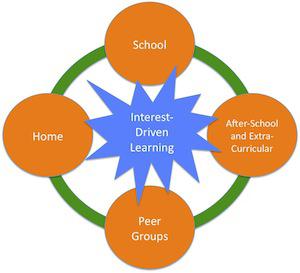We also wanted to share these readings and resources for further discussion:
Seymour Papert (1994): The Children’s Machine, Chapter 7: Instructionism versus Constructionism
“Seymour helped me understand that the most important changes in education will come not from better ways to instruct but from better ways to help learners construct.” (Mitch)
Dale Dougherty: The Maker Mindset and Learning by Making
“Through MAKE magazine and Maker Faires, Dale has helped spread the constructionist vision of learning through making.” (Mitch)
Mitchel Resnick et al. (2009): Scratch: Programming for All. Communications of the ACM.
“This overview of Scratch was written for the computer science community, but is an accessible summary of our goals for Scratch and how young people have been using it.” (Natalie)
Mitchel Resnick (2012). Let’s Teach Kids to Code. TED Talk video.
“Some high school students have written to say they’ve been inspired by Mitch’s TED Talk to help teach other kids how to code.” (Natalie)
Mitchel Resnick. (2013). Learn to Code, Code to Learn. EdSurge, May 2013
“A brief summary of the ideas in Mitch’s TED Talk--on coding to learn (not just learning to code).” (Natalie)
Mitchel Resnick & Brian Silverman (2005): Some Reflections on Designing Construction Kits for Kids. Interaction Design and Children conference.
“A set of design principles, which provoked discussion and debate in last year’s local LCL class. I agree that one of them is problematic, but overall I find them helpful and interesting.” (Natalie)




 This work from Mimi Ito's blog last year solidified many concepts for me. I keep asking, "How to reach the children that might only have exposure during the traditional school day?"
This work from Mimi Ito's blog last year solidified many concepts for me. I keep asking, "How to reach the children that might only have exposure during the traditional school day?"






